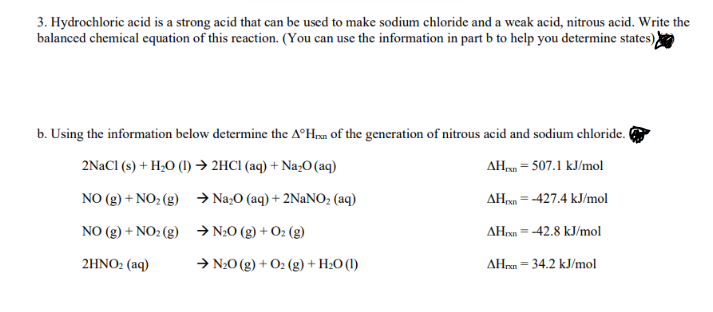3. Hydrochloric acid is a strong acid that can be used to make sodium chloride and a weak acid, nitrous acid. Write the balanced chemical equation of this reaction. (You can use the information in part b to help you determine states)) b. Using the information below determine the AºHrn of the generation of nitrous acid and sodium chloride. 2NACI (s) + H;O (I) → 2HCI (aq) + Na;O(aq) AH, = 507.1 kJ/mol NO (g) + NO2 (g) → Na;O (aq) + 2NaNO; (aq) AH = -427.4 kJ/mol NO (g) + NO2 (g) → N;0 (g) + O2 (g) AHrxm =-42.8 kJ/mol 2HNO2 (aq) → N2O (g) + O2 (g) + H20 (I) AHrn = 34.2 kJ/mol %3D
3. Hydrochloric acid is a strong acid that can be used to make sodium chloride and a weak acid, nitrous acid. Write the balanced chemical equation of this reaction. (You can use the information in part b to help you determine states)) b. Using the information below determine the AºHrn of the generation of nitrous acid and sodium chloride. 2NACI (s) + H;O (I) → 2HCI (aq) + Na;O(aq) AH, = 507.1 kJ/mol NO (g) + NO2 (g) → Na;O (aq) + 2NaNO; (aq) AH = -427.4 kJ/mol NO (g) + NO2 (g) → N;0 (g) + O2 (g) AHrxm =-42.8 kJ/mol 2HNO2 (aq) → N2O (g) + O2 (g) + H20 (I) AHrn = 34.2 kJ/mol %3D
Chemistry: Principles and Practice
3rd Edition
ISBN:9780534420123
Author:Daniel L. Reger, Scott R. Goode, David W. Ball, Edward Mercer
Publisher:Daniel L. Reger, Scott R. Goode, David W. Ball, Edward Mercer
Chapter5: Thermochemistry
Section: Chapter Questions
Problem 5.36QE: When lightning strikes, the energy can force atmospheric nitrogen and oxygen to react to make NO:...
Related questions
Question

Transcribed Image Text:3. Hydrochloric acid is a strong acid that can be used to make sodium chloride and a weak acid, nitrous acid. Write the
balanced chemical equation of this reaction. (You can use the information in part b to help you determine states),
b. Using the information below determine the AºHrn of the gencration of nitrous acid and sodium chloride.
2NACI (s) + H;O (1) → 2HCI (aq) + Na;O (aq)
AH, = 507.1 kJ/mol
NO (g) + NO2 (g) → Na;O (aq) + 2NaNO; (aq)
AH,n = -427.4 kJ/mol
NO (g) + NO2 (g) →N20 (g) +
AHrxn = -42.8 kJ/mol
(8)
2HNO2 (aq)
→ N20 (g) + O2 (g) + H2O (I)
AHrn = 34.2 kJ/mol
Expert Solution
This question has been solved!
Explore an expertly crafted, step-by-step solution for a thorough understanding of key concepts.
This is a popular solution!
Trending now
This is a popular solution!
Step by step
Solved in 2 steps with 2 images

Knowledge Booster
Learn more about
Need a deep-dive on the concept behind this application? Look no further. Learn more about this topic, chemistry and related others by exploring similar questions and additional content below.Recommended textbooks for you

Chemistry: Principles and Practice
Chemistry
ISBN:
9780534420123
Author:
Daniel L. Reger, Scott R. Goode, David W. Ball, Edward Mercer
Publisher:
Cengage Learning

Chemistry: Principles and Reactions
Chemistry
ISBN:
9781305079373
Author:
William L. Masterton, Cecile N. Hurley
Publisher:
Cengage Learning

Chemistry & Chemical Reactivity
Chemistry
ISBN:
9781133949640
Author:
John C. Kotz, Paul M. Treichel, John Townsend, David Treichel
Publisher:
Cengage Learning

Chemistry: Principles and Practice
Chemistry
ISBN:
9780534420123
Author:
Daniel L. Reger, Scott R. Goode, David W. Ball, Edward Mercer
Publisher:
Cengage Learning

Chemistry: Principles and Reactions
Chemistry
ISBN:
9781305079373
Author:
William L. Masterton, Cecile N. Hurley
Publisher:
Cengage Learning

Chemistry & Chemical Reactivity
Chemistry
ISBN:
9781133949640
Author:
John C. Kotz, Paul M. Treichel, John Townsend, David Treichel
Publisher:
Cengage Learning

Chemistry & Chemical Reactivity
Chemistry
ISBN:
9781337399074
Author:
John C. Kotz, Paul M. Treichel, John Townsend, David Treichel
Publisher:
Cengage Learning

General Chemistry - Standalone book (MindTap Cour…
Chemistry
ISBN:
9781305580343
Author:
Steven D. Gammon, Ebbing, Darrell Ebbing, Steven D., Darrell; Gammon, Darrell Ebbing; Steven D. Gammon, Darrell D.; Gammon, Ebbing; Steven D. Gammon; Darrell
Publisher:
Cengage Learning

Chemistry by OpenStax (2015-05-04)
Chemistry
ISBN:
9781938168390
Author:
Klaus Theopold, Richard H Langley, Paul Flowers, William R. Robinson, Mark Blaser
Publisher:
OpenStax